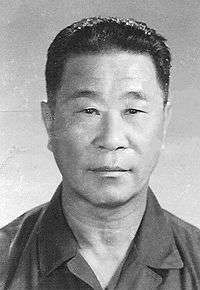Chan Tai San
Chan Tai San (Chan Tai-San; Chinese: 陳泰山) (July 12, 1920 – September 1, 2004) was a Chinese martial arts grandmaster.[1] Often called one of China's "living treasures", Chan was featured as such on the cover of Inside Kung Fu magazine in 1996.[2]
| Chan Tai San | |
|---|---|
 T. S. Chan, c. 1980 | |
| Born | 12 July 1920 |
| Died | 1 September 2004 (aged 84) |
| Style | Kung fu |
| Rank | Grandmaster |
Early training and military service
Chan said he began kung fu training at age eight under Yee Hoi-Long (余海龍), a stonemason who worked for the Chan family.[2] Yee taught "hung fist", also called "hung kuyhnn" or "village style", a forerunner to hung ga, and "hung tao choy mei" (which means "hung head choy tail"), later known as jow ga, a system combining strong "hung" style fist work with active choy-style footwork. Chan learned from Yee for about six years.[2]
Chan was 13 when, after the death of his father, he was sent by his family to the Clear Cloud Temple where he began training in kung fu and Buddhism and was mostly a student of Jyu Jik Chuyhn (朱亦傳).[2][3][4] Chan was also taught by the monk Gaai Si Wu Song and trained mostly in the choy lay fut style.[5]
At 17, Chan left the monastery to fight against the Imperial Japanese Army, enlisting in a peasant division which also had some of the most skilled traditional martial arts fighters in China. While in the army, Chan trained and served with Cheung Lai-Chung 張禮泉 (bak mei, "white eyebrow" style), baahk mo jyu 洪瑋翔 (nicknamed the "white haired devil", hung fut style) and others.[2]
Career
After the war, Chan traveled throughout China meeting and training with more sifu such as Mok Jing-Kiu (head of the Mok family style) and Chan Sai-Mo陳世武 (choy lay fut style) and Chan Jik Seung 陳績常 (bak mei). In his 40s, Chan went back to the Clear Cloud Temple and learned lama pai (喇嘛派) from Jyu Jik Chuyhn.[2] Other arts he trained in were the southern eagle claw, also known as golden eagle, the ngok ga style as well as the Jow Ga Style under Jow Biu. Devoting himself to mastering the Tibetan lion's roar system, he trained with various sifu of related lineages such as Deng Gum To (鄧錦濤) of the hop ga and Gung Yuet Gei 孔乙己 of white crane and a Mai Yi Po of Lama from Mongolia.
Chan trained and promoted Chinese martial arts in China and abroad. He was coach of the Guangdong Province martial arts demonstration team from 1980 to 1982, a hand-to-hand fighting (sanshou) instructor for an elite fut san military unit, and a member of the executive committee of the Toi San region martial arts association.[6] As a member of the national demonstration team (and through exhibitions at national level tournaments in the United States), Chan demonstrated internal martial arts (qigong), iron palm and iron body.
Chan was one of only a few instructors who openly taught the lama pai style. When he opened his classes to Americans, there were estimated to be only five other public lama pai sifu in the world.[4][7]
Footnotes
- Yee's Hung Ga Association newsletter.
- Cater, Dave: "Chan Tai San's Journey of a Lifetime", Inside Kung Fu (October 1996), pp. 38–41.
- Parrella, M.: Chan Tai San's lineage Archived July 28, 2011, at the Wayback Machine Retrieved 27 December 2009.
- Inside Kung Fu (October 1989).
- Cater, Dave (1993): "A Tradition Whose Time has Come", Inside Kung Fu (September 1993), p. 56.
- Cater, Dave: "A Tradition Whose Time has Come", Inside Kung Fu (September 1993).
- Ross, David: "The Lion's Roar", KungFu Wushu (Winter 1995).
- Ross, David: "Is Traditional Practical?", KungFu Wushu (October/November 1996).
- Slovenz, Madeline Anita: "The Year Is a Wild Animal: Lion Dancing in Chinatown", Drama Review, Vol. 31 No. 3 (Autumn 1987), pp. 74–102.